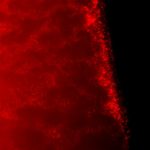Lien vers Pubmed [PMID] – 1614411
Mol. Pharmacol. 1992 Jun;41(6):1089-95
[3H]Propionyl-Tyr-(SO3H)-gNle-mGly-Trp-(NMe)Nle-Asp-Phe-NH2 ([3H]pBC 264) (98-100 Ci/mmol), a new peptidase-resistant cholecystokinin (CCK) agonist that is 1000-fold more potent for CCK-B than for CCK-A receptors, interacts, with a similar subnanomolar affinity, with a single class of binding sites (Kd, 0.15-0.2 nM) in brain membranes of mouse, rat, guinea pig, and cat, in Tris and Krebs buffers. The concentration of CCK-A receptors in rodent brain was estimated to be 8-10 fmol/mg of protein, by measurement of the Bmax values of the nonselective agonist [3H] propionyl-CCK8, with or without 10 nM pBC 264 to saturate CCK-B sites. In guinea pig and mouse brain, specific [3H]pBC 264 binding was not affected by NaCl and/or guanyl-5′-yl-imidodiphosphate. In contrast, in rat brain the affinity of [3H]pBC 264 was decreased and the maximal number of binding sites was increased by NaCl and the guanyl nucleotide or by alkaline treatment, suggesting that a proportion of CCK-B receptors are linked to guanine nucleotide-binding proteins. The Bmax of a CCK8 analog, [3H]SNF 8702, was higher (57 fmol/mg of protein) than that of [3H]pBC 264 (40 fmol/mg of protein) in guinea pig brain cortex but not in mouse brain. The relative potencies of various analogs differed among species. The CCK-B antagonist L365,260 was 18-, 30-, and 64-fold less potent than [3H]pBC 264 in guinea pig, mouse, and rat, respectively. PD 134308, a CCK-B antagonist, was 20-fold less potent in rat brain than in guinea pig brain. Likewise, the cyclic analog BC 254 displayed a 30- and 60-fold lower affinity for mouse and rat than for guinea pig brain preparations. Together, these results suggest the presence of CCK-B receptor subtypes. In all tissues, the specific binding of [3H]pBC 264 at its Kd values was very high (75-90%) and higher than that of the hydrophobic CCK-B probe [3H]SNF 8702 (approximately 50%). Therefore, unlike [3H]SNF 8702, [3H]pBC 264 can be used to study preparations with low receptor concentrations, such as rat brain, making this radiolabeled molecule the most appropriate ligand available to date for CCK-B receptor studies.

